Growing your own Sapodilla tree (also known as Chikoo, Naseberry, or Manilkara zapota) in pots is not only possible but incredibly rewarding. This tropical fruit tree, loved for its sweet, malty flavor and brown sugar-like taste, can thrive beautifully in containers with the right care and environment. Whether you live in an apartment with limited garden space or simply want to decorate your terrace with a fruiting tree, growing sapodilla in pots is a great choice.
In this guide, we’ll explore everything you need to know — from seed preparation to fruiting — so you can successfully grow your very own sapodilla tree with fruits in pots at home.
Understanding the Sapodilla Tree
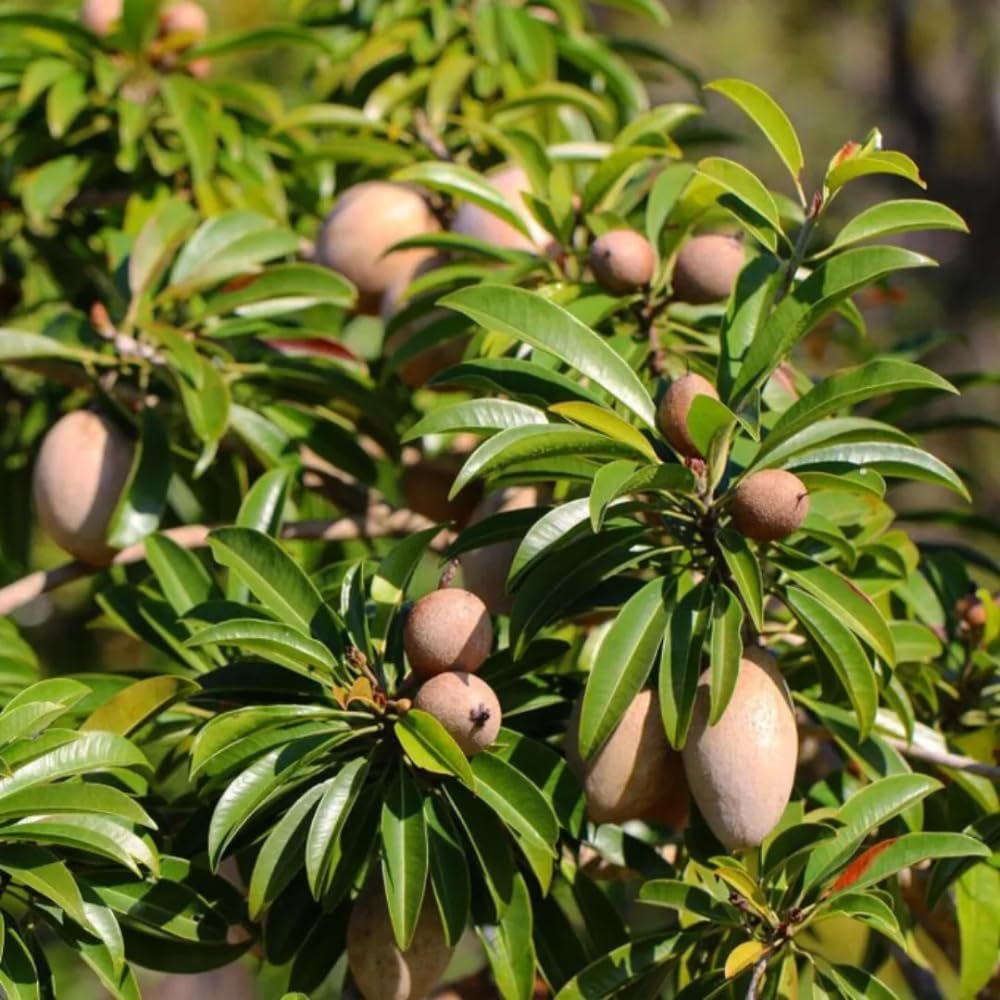
Sapodilla is a tropical evergreen tree native to Central America, but it has become widely cultivated in India, Thailand, the Philippines, and other warm regions. It’s prized for its sweet, grainy pulp, which tastes similar to brown sugar mixed with pear and caramel.
The tree grows slowly but steadily, developing glossy green leaves and small, fragrant flowers. While it can grow large in the ground, in pots, you can easily manage its size and still get a healthy fruit yield with regular pruning and proper care.
Choosing the Right Pot for Sapodilla
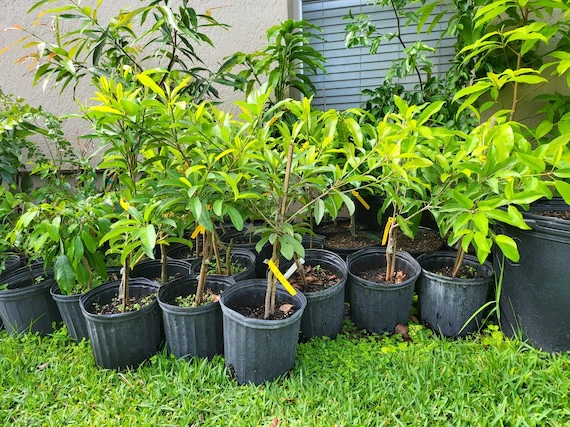
When growing sapodilla in pots, the container size is the first thing you should consider.
- Size: Start with a 15–20 inch (40–50 cm) diameter pot if you’re planting a young sapodilla tree. As the plant grows, you can repot it into a larger 25–30 inch container.
- Material: Choose clay or ceramic pots for better air circulation and temperature regulation. Plastic pots work too but ensure they have good drainage holes.
- Drainage: Always ensure multiple drainage holes at the bottom of the pot. Sapodilla roots dislike waterlogging and can rot if excess water stays trapped.
For best results, place your pot on a stand or bricks to improve airflow and prevent root rot.
Selecting the Right Sapodilla Variety
Sapodilla has several cultivars, and not all perform equally well in pots. Here are some compact or early-fruiting varieties that are ideal for container gardening:
- Kalipatti (India): Sweet flavor, medium-sized fruits, ideal for home gardeners.
- Prolific (Philippines): Early-fruiting and high-yielding.
- Silas Woods (Florida, USA): A dwarf variety that produces well in containers.
- Alano (Thailand): Known for its rich sweetness and long shelf life.
If you can find a grafted sapodilla plant, it’s the best option. Grafted plants start bearing fruit within 3–4 years, while those grown from seeds can take 6–8 years to fruit.
Preparing the Ideal Potting Mix
Sapodilla trees prefer well-drained, slightly sandy, and nutrient-rich soil. Since potted plants depend entirely on you for nutrients, a balanced mix is essential.
Recommended potting mix:
- 40% garden soil or loamy soil
- 30% organic compost or cow dung manure
- 20% river sand or perlite for aeration
- 10% cocopeat or leaf mold to retain moisture
You can also add a handful of bone meal or neem cake powder to enrich the soil and keep pests away.
Make sure to mix everything thoroughly before planting.
Ideal Growing Conditions
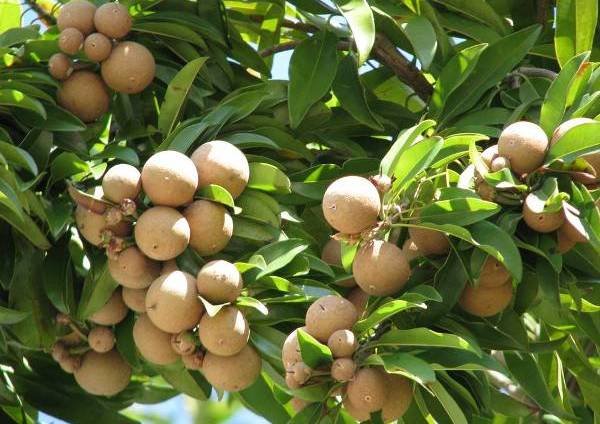
Sapodilla is a sun-loving tropical fruit tree, so it needs warm conditions to thrive.
- Sunlight: Place the pot in a location that receives at least 6–8 hours of direct sunlight daily.
- Temperature: Sapodilla grows best in warm climates (25–35°C). Protect it from frost and cold winds.
- Humidity: Moderate humidity levels help the plant stay lush and healthy.
If you live in a cooler region, keep the pot indoors near a sunny window during winter or use a small greenhouse setup.
Planting Sapodilla in Pots
- Filling the pot: Add a layer of gravel or small stones at the bottom of the pot to ensure drainage.
- Adding the soil mix: Fill the container two-thirds with your prepared potting mix.
- Planting: Place your grafted sapodilla plant or seedling in the center and fill the remaining space with soil, gently pressing it around the roots.
- Watering: Water thoroughly after planting and keep the soil slightly moist for the first week to help the roots establish.
For seed-grown plants, soak the seeds overnight and plant them about 1 inch deep in moist soil. Germination takes 2–3 weeks, depending on the temperature.
Watering Schedule
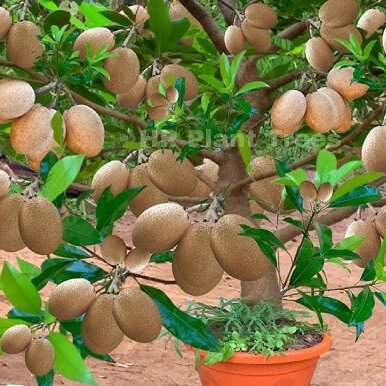
Sapodilla trees are moderately drought-tolerant but need consistent moisture, especially in pots.
- Young plants: Water 2–3 times per week to keep the soil moist but not soggy.
- Mature plants: Once established, water deeply once a week.
- Avoid overwatering: Waterlogged soil can cause root rot and leaf drop.
During summer, increase watering frequency, and reduce it in winter.
A good tip: Water only when the top 2 inches of soil feel dry.
Fertilizing for Healthy Growth and Fruiting
Regular feeding is essential to promote lush growth and fruiting in container-grown sapodilla.
- Organic fertilizer: Apply well-rotted compost or vermicompost every 2–3 months.
- Liquid feed: Once a month, use a liquid seaweed or fish emulsion fertilizer to boost nutrient levels.
- Fruit booster: During the flowering and fruiting stage, add a potassium-rich fertilizer (like banana peel compost or wood ash) to encourage sweet fruit development.
Avoid using too much nitrogen fertilizer, as it promotes leaf growth instead of flowers and fruits.
Pruning and Maintenance
Pruning helps maintain the shape of the sapodilla tree and encourages better airflow and sunlight penetration.
- When to prune: The best time is after the fruiting season or at the start of spring.
- What to remove: Cut off any dead, diseased, or crossing branches.
- Shape maintenance: Keep the plant short and bushy by trimming the top growth occasionally.
You can also pinch off young shoots to encourage side branching, making the tree more compact and ornamental.
Flowering and Fruit Development
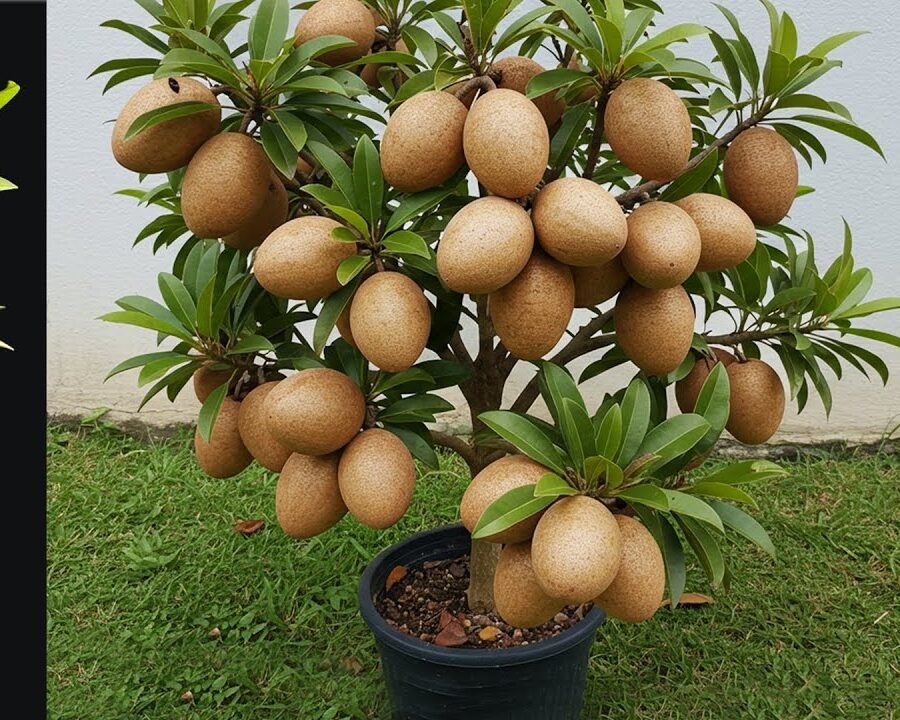
A well-cared sapodilla tree will start to flower within 2–3 years (if grafted). The small, creamy-white flowers are self-pollinating, but gentle shaking of branches during flowering can help improve fruit set.
- Pollination: Bees and small insects are natural pollinators for sapodilla.
- Fruit growth: After pollination, the fruits start small and green and take 6–8 months to mature fully.
- Harvest time: The fruits are ready when the skin turns light brown and the surface becomes slightly rough.
Avoid picking them too early; raw fruits can taste bitter and milky due to latex content.
Common Problems and Solutions
Even though sapodilla is a hardy plant, it can face some common issues:
- Yellow Leaves: Usually caused by overwatering or poor drainage.
→ Fix: Improve drainage and water only when necessary. - No Flowers or Fruits: Can happen if the plant isn’t getting enough sunlight or nutrients.
→ Fix: Move to a sunnier spot and add potassium-rich fertilizer. - Insects (Aphids, Mealybugs, Scale): These pests suck sap from leaves and stems.
→ Fix: Spray neem oil or insecticidal soap every 10–15 days until the problem clears. - Fruit Drop: Often due to temperature fluctuations or irregular watering.
→ Fix: Maintain consistent moisture and stable growing conditions.
Harvesting and Enjoying Your Sapodilla Fruit
The most exciting part of growing sapodilla is harvesting your first batch of homegrown fruits. When ripe, sapodilla fruits are soft to the touch and give a gentle, sweet aroma.
- Harvest carefully without damaging the branches.
- Let slightly underripe fruits sit indoors for 2–3 days to ripen fully.
- Enjoy fresh sapodillas as a dessert fruit or add them to smoothies and ice creams for a tropical twist.
Final Tips for Success
- Use grafted plants for faster fruiting.
- Provide consistent sunlight and warmth.
- Maintain good drainage and moderate watering.
- Prune regularly to keep the plant healthy and compact.
- Add organic matter frequently to replenish nutrients in the pot.
With proper care, your potted sapodilla tree can produce delicious fruits year after year — turning your balcony, terrace, or patio into a mini tropical paradise.
Conclusion
Growing a sapodilla tree with fruits in pots is an enjoyable and rewarding gardening project. With patience, care, and attention to detail, you can enjoy fresh, sweet sapodillas from your own home garden. The process may take time, but the satisfaction of harvesting your own fruits makes every effort worthwhile.
Whether you’re an urban gardener or a tropical fruit lover, this project is proof that good skills and consistent care can turn any small space into a fruit-bearing garden.






Leave A Comment